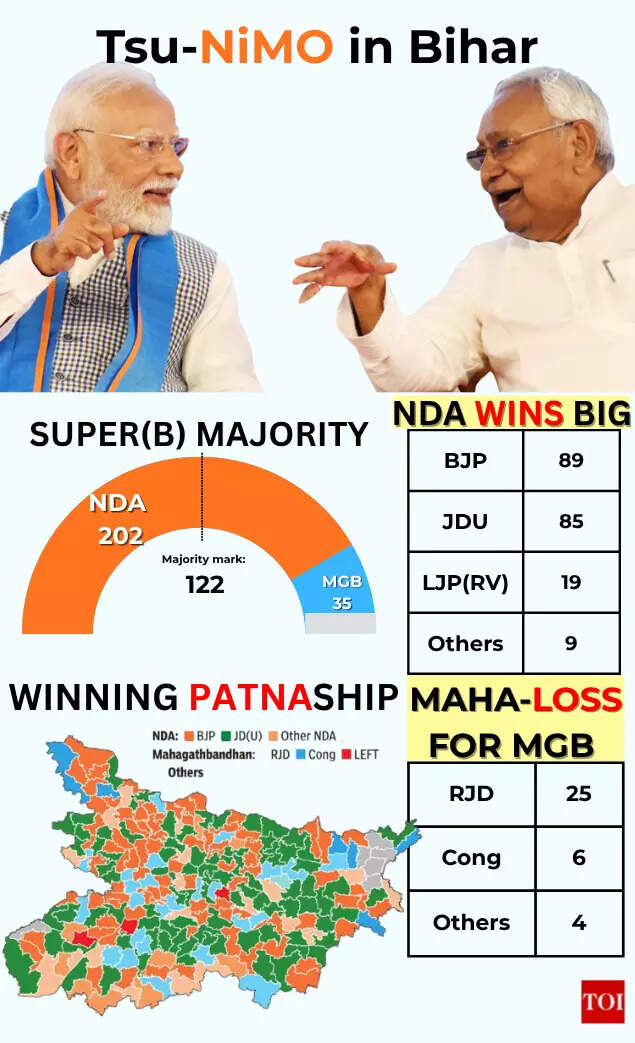NEW DELHI: Bihar’s 2025 election results threw up a story full of surprises. Tejashwi Yadav’s RJD turned out to be the party with highest vote share in the state, yet it ended up with one of its lowest seat tallies ever. On the other hand, the NDA kept the power with landslide victory, clinching over 200 seats in 243-member assembly, keeping the Mahagathbandhan far from the seat of government.
High votes, low wins: The big contradiction
RJD recorded a vote share of around 23 percent, just few decimals down from 2020, when it got 23.11 and emerged as the largest party with 75 seats. But this time, that same level of popularity translated into just 25 seats. So the big question is: how can a party get the most votes, yet finish into just 25 seats, a huge loss of 50 from the last elections. So the striking question is: how can a party get the most votes, yet finish with so few seats? The answer lies in how votes were spread. RJD seems to have polled a large number of second-position votes. It remained popular, but not with enough concentrated support in winning zones.

In simple terms, RJD got votes but not victories. This is no surprise in India’s electoral mechanism of ‘First Past the Post System.’
Contest more seats
RJD contested 143 seats this time, the highest among all parties across both the NDA and the Mahagathbandhan. In the 2020 assembly elections, the Lalu-led party had fielded one more candidate, contesting 144 seats. Contesting widely helped the party accumulate more total votes, contributing to the highest vote share. But losing candidates also add to vote share totals.Meanwhile, BJP and JD(U) fought on 101 seats each. They contested fewer seats but converted their votes efficiently into victories. That is why their seat count shot up, even with a lower vote share than RJD.
NDA’s math clicked, MGB’s math cracked
A major turning point this election was the return of Chirag Paswan’s LJP (Ram Vilas) to the NDA camp. In 2020, the LJP had hurt the NDA’s chances by cutting into its votes, but this time its support helped strengthen the alliance instead of splitting it.

In the previous election, LJP (RV) was unhappy with the NDA’s seat-sharing formula in Bihar. Even though it was part of the alliance at the Centre, Chirag Paswan chose to go solo in the state and contested 134 seats, which ended up damaging NDA numbers—especially Nitish Kumar’s JD(U). Similarly, Upendra Kushwaha’s party contested 104 seats independently in 2020, further cutting into votes that could have benefitted the NDA.This time, with both LJP (RV) and Kushwaha’s RLM back in the NDA fold, the alliance appeared far more united, organised, and prepared. The result: NDA outperformed the Mahagathbandhan by a wide margin.
JD(U)’s comeback flipped the story
One of the biggest turnarounds happened in seats where RJD and JD(U) were in direct fight.In 2020, RJD dominated these contests. But in 2025, JD(U) turned the tables and won 50 out of 59, almost wiping out RJD in head-to-head battles. JD(U)’s vote share also jumped from 15.39 percent in 2020 to 19.25 percent this time, helping it win 85 seats from the tally of 43 last time.RJD simply failed to see this drastic reversal coming.
BJP grows bigger than ever
The BJP crossed 89 seats, its highest tally ever in Bihar, marking a historic leap for a party that once had almost no grassroots base or ideological legacy in the state. By staying aligned for years with “sushasan babu” and steadily expanding its footprint, the saffron party has now grown into Bihar’s biggest political force.

With this mandate, the BJP has effectively redrawn the political map of Bihar. It now sits at the centre of power, holding the strongest bargaining position in the alliance. For years, Nitish Kumar played the “big brother” to the BJP, but for the second election in a row, the BJP has outperformed the JD(U), this time doing so with its best-ever numbers. The shift isn’t just about arithmetic — it’s psychological. For decades, Bihar’s political story revolved around the Lalu–Nitish axis. Today, it revolves around the BJP’s weight, influence and negotiating power.
MGB slipped because allies didn’t deliver
Unlike NDA, the Mahagathbandhan struggled with coordination and clarity.Congress contested on 61 seats as compared to last time’s 70, but won only six. The Left parties, which surprised everyone in 2020, could not repeat their performance either. Seat-sharing disagreements and confusing “friendly fights” meant votes did not transfer smoothly within the alliance.

The opposition was visible but not united — and unity decides tight contests.
Jan Suraaj and AIMIM changed the margins
Prashant Kishor’s much-talked about startup — Jan Suraaj did not open its account, but it made a strategic dent, in at least 35 seats, its vote share was higher than the winning margin, influencing outcomes for both alliances. Meanwhile, AIMIM repeated its strong Seemanchal performance, winning five seats with 1.85 percent of votes and signalling a shift in political thinking among Muslim voters. The traditional Muslim–Yadav (MY) vote base of the RJD showed signs of fragmentation, with Muslim voters exploring alternative platforms in multiple constituencies, leading to a near wipeout of the Mahagathbandhan in Seemanchal, barring one Congress candidate who scraped through.Mayawati’s BSP also registered a presence, securing 1.62% of the total vote share with one seat in the west.
So, what really happened?
RJD did not lose popularity, but lost positional advantage. It remained a strong choice for many voters but could not cross the finishing line often enough. High vote share created the impression of strength, but seats reflect actual power — and that is where NDA towered above everyone. Go to Source


